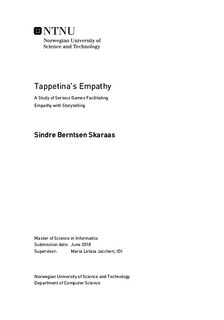Tappetina's Empathy - A Study of Serious Games Facilitating Empathy with Storytelling
Abstract
Background: Empathy is the ability for people to understand other people smotivations, positions, and emotions. This is an important way for people torelate to each other and much research has been done to find out how seriousgames affects empathy. Much of it has, however, been focusing on negativeimpacts, which encourage anti-social behavior and reduce empathy. Thereis still a notable potential for games to have a positive impact on pro-socialbehavior by encouraging and building empathy.
Objective: This thesis investigates how a serious game can affect playersin such a way, through the use of storytelling. First part of this objectiveis to do a literature review, which lays out discussions, reports and gameprojects on the topic of serious games, empathy and storytelling. The secondpart of the objective is to do design and develop a storytelling game. Byhaving players collaborate on telling a story, the game aims to exercise theirempathic abilities. Each player uses a smartphone which displays the storystructure and grants new cues for building the story together.
Method: The research performed here is design and creation, in which themain results is the design discussion and the game artifact (including thedigital solution, and the flow of the physical activity). The game is thenevaluated with a second research strategy, a quasi-experiment. This tookplace in a workshop trial with 12 participants.
Results: Contributions include the game activity, and the results of the literaturereview and the evaluation: Participants responded positively and enjoyedplaying the game. The participants showed different abilities to builda story, and various reactions that suggested links to empathy.
Limitations: The game is still in an early stage and the quasi-experimentwas too small to accurately generalize. A more streamlined game needs tobe systematically evaluated to a larger audience.
Conclusion: The evaluation showed enough potential to use this approachto empathy through storytelling. Two scientific papers were written, one ofwhich was published and the game will be presented at the IDC conference. The project has also been further developed and researched based on the process and design outlined in this thesis, to better facilitate empathicresponses.
